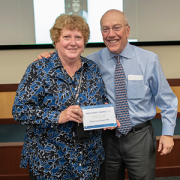Guiding a new path for emergency medical care training

Susannah Jenkins, PA-C, guides a new training program for physician assistants.
Susannah Jenkins, PA-C, lead physician assistant with the emergency medicine and trauma services department at Children’s National Health System, celebrates three years at Children’s National this September and she’s glad she transitioned from an adult surgical environment to the fast-paced, dynamic environment of working in pediatric emergency medicine (PEM).
With 25 years of health care experience, 13 years as a physician assistant and 12 years as a nurse, Jenkins has worked in a variety of settings, inclusive of adult neurosurgery and high-risk OBGYN care.
“My passion is helping everyone heal, but I particularly enjoy working with children,” notes Jenkins. “Children have an extraordinary ability to bounce back after a fall and recover from a bout of seasonal, flu-like illness. A dose of medication or the correct diagnosis, paired with the right treatment, can sometimes make everything better, almost instantaneously, which is one of the most rewarding parts of working in this field. You get to help and see children heal.”
In addition to providing treatment for a range of pediatric patients, Jenkins works with Deena Berkowitz, M.D., M.P.H., a pediatric emergency medicine physician and assistant professor of pediatrics and emergency medicine at Children’s National and the George Washington University School of Medicine and Health Sciences, to train physician assistants, or PAs, to respond to urgent care needs within a Level 1 trauma center. With the encouragement and guidance of Dr. Berkowitz and Robert J. Freishtat, M.D., M.P.H., chief of emergency medicine at Children’s National, Jenkins expanded on an emergency medicine training program for PAs, which started at Children’s National in 2012.
Jenkins presents the 12-month module at the American Academy of Physician Assistants 2018 Annual Conference in New Orleans on Saturday, May 19, 2018.
Jenkins’ poster presentation, coauthored by Dr. Berkowitz, details the objectives, timeline, curriculum components and results that correspond with providing eight PAs with a 12-month training program to treat low-acuity pediatric patients at a Level 1 trauma center.
The eight PAs who completed the 12-month program in 2017-18 saw 14 percent of the emergency care department’s low-acuity pediatric patients – patients seeking treatment for basic care, such as ear infections, conjunctivitis or strep throat – after 12 months of exhibiting competency in the program. The structured curriculum includes a two-month orientation followed by a 10-month provisional training module, inclusive of CME submissions, scientific literature reviews, journal discussions, case studies, chart reviews, team-based care and competency reviews.
“This is all about education,” notes Jenkins. “We’re here to support the PA and we aim to answer questions they have about education goals, competency goals and practice goals in an institutional setting. This template provides the foundation to bridge the gap between post-graduation studies with the skills PAs need and are eager to develop throughout their career.”
Jenkins is currently working with Dr. Berkowitz to develop guidelines for PAs treating medium-acuity patients, inclusive of patients seeking a higher level of primary care, such as for appendicitis, and for PA-training-programs that extend past one year. Jenkins notes the 12-month program she presents at the American Academy of Physician Assistants 2018 Annual Conference is a template that can be applied to any PA subspecialty and is a desirable program for both employers and PA applicants.
“Ultimately, I sought to provide a guide that answered all of my questions I had as a new graduate and as a seasoned PA entering the new subspecialty of pediatric emergency medicine,” says Jenkins. “This program blends the academic science with clinical case studies and practice competencies, making it a modifiable learning platform that’s beneficial for everyone – but specifically designed for PAs. Remember, they enter the field with the desire to support physicians and their patients.”
Her guiding question isn’t on the final test but it helps her with the program design: How can we train PAs to provide the kind of care we want for our children, for our families and for our neighbors?
“I am proud of all of the PAs in this program and of all of the PAs I work with,” Jenkins concludes. “I actively refer them to family members and friends seeking urgent pediatric care. I am confident in the abilities of my group. They represent the type of provider I would send my family and my friends to see, and ultimately your family and friends to see, if they were in need.”
Dr. Berkowitz agrees and is happy with the success the program has had in preparing an average of six to eight PAs each year with the tools they need to launch their career.
Download a copy of “Bridging the post-graduation gap: A 12 month curriculum for PAs entering Pediatric Emergency Medicine.”











